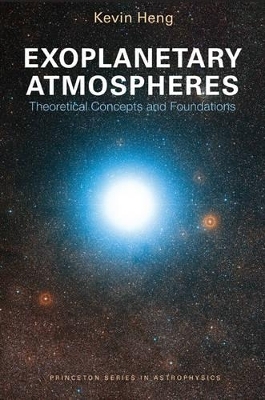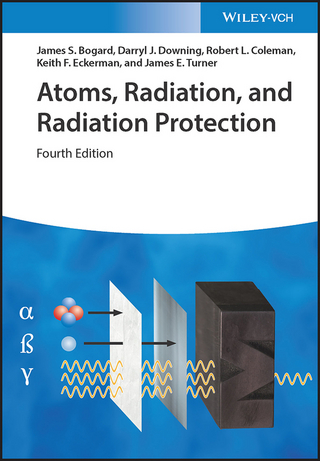
Exoplanetary Atmospheres
Princeton University Press (Verlag)
978-0-691-16698-8 (ISBN)
* The first graduate textbook on the theory of exoplanetary atmospheres* Unifies knowledge from atmospheric and climate science, astronomy and astrophysics, chemistry, planetary science, and more* Covers radiative transfer, fluid dynamics, atmospheric chemistry, and atmospheric escape* Provides simple analytical models and a wealth of problem sets* Includes appendixes on thermodynamics, vector calculus, tabulated Gibbs free energies, and Python scripts* Solutions manual (available only to professors)
Kevin Heng is professor of astronomy and planetary sciences at the University of Bern in Switzerland, where he is director of the Center for Space and Habitability and leads the Exoplanets and Exoclimes Group, and is on the core science team of the CHEOPS space mission of the European Space Agency.
Foreword by Sara Seager xi Preface xiii 1 Observations of Exoplanetary Atmospheres: A Theorist's Review of Techniques in Astronomy 1 1.1 The birth of exoplanetary science 1 1.2 Transits and occultations 2 1.3 Radial velocity measurements 8 1.4 Direct imaging 11 1.5 Gravitational microlensing 12 1.6 Future missions and telescopes 12 2 Introduction to Radiative Transfer 14 2.1 The optical depth: The most fundamental quantity in radiative transfer 14 2.2 Basic quantities in radiative transfer 16 2.3 The radiative transfer equation 20 2.4 Simple solutions of the radiative transfer equation 20 2.5 A practical checklist for radiative transfer calculations 23 2.6 Clouds 24 2.7 Atmospheric retrieval 27 2.8 Problem sets 31 3 The Two-Stream Approximation of Radiative Transfer 35 3.1 What is the two-stream approximation? 35 3.2 The radiative transfer equation and its moments 36 3.3 Two-stream solutions with isotropic scattering 39 3.4 The scattering phase function 45 3.5 Two-stream solutions with non-isotropic scattering 46 3.6 Different closures of the two-stream solutions 49 3.7 The diffusion approximation for radiative transfer 51 3.8 Problem sets 53 4 Temperature-Pressure Profiles 56 4.1 A myriad of atmospheric effects: Greenhouse warming and antigreenhouse cooling 56 4.2 The dual-band or double-gray approximation 57 4.3 The radiative transfer equation and the scattering parameter 58 4.4 Treatment of shortwave radiation 60 4.5 Treatment of longwave radiation 64 4.6 Assembling the pieces: Deriving the general solution 65 4.7 Exploration of different atmospheric effects 67 4.8 Milne's solution and the convective adiabat 71 4.9 Problem sets 72 5 Atmospheric Opacities: How to Use a Line List 74 5.1 From spectroscopic line lists to synthetic spectra 74 5.2 The Voigt profile 76 5.3 The quantum physics of spectral lines 78 5.4 The million- to billion-line radiative transfer challenge 81 5.5 Different types of mean opacities 88 5.6 Problem sets 89 6 Introduction to Atmospheric Chemistry 92 6.1 Why is atmospheric chemistry important? 92 6.2 Basic quantities: Gibbs free energy, equilibrium constant, rate coefficients 93 6.3 Chemical kinetics: Treating chemistry as a set of mass conservation equations 101 6.4 Self-consistent atmospheric chemistry, radiation and dynamics: A formidable computational challenge 106 6.5 Problem sets 107 7 A Hierarchy of Atmospheric Chemistries 110 7.1 A hierarchy of models for understanding atmospheric chemistry 110 7.2 Equilibrium chemistry with only hydrogen 110 7.3 Equilibrium C-H-O chemistry: Forming methane, water, carbon monoxide and acetylene 113 7.4 Equilibrium C-H-O chemistry: Adding carbon dioxide 115 7.5 Equilibrium C-H-O chemistry: Adding ethylene 121 7.6 Problem sets 122 8 Introduction to Fluid Dynamics 123 8.1 Why is the study of fluids relevant to exoplanetary atmospheres? 123 8.2 What exactly is a fluid? 124 8.3 The governing equations of fluid dynamics 124 8.4 Potential temperature and potential vorticity 128 8.5 Dimensionless fluid numbers 130 8.6 Problem sets 132 9 Deriving the Governing Equations of Fluid Dynamics 135 9.1 Preamble 135 9.2 The mass continuity equation (mass conservation) 135 9.3 The Navier-Stokes equation (momentum conservation) 136 9.4 The thermodynamic equation (energy conservation) 138 9.5 The conservation of potential vorticity 139 9.6 Various approximate forms of the governing equations of fluid dynamics 143 9.7 Magnetohydrodynamics 147 9.8 Problem sets 151 10 The Shallow Water System: A Fluid Dynamics Lab on Paper 155 10.1 A versatile fluid dynamics laboratory on paper 155 10.2 Deriving the shallow water equations 156 10.3 Gravity as the restoring force: The generation of gravity waves 158 10.4 Friction in an atmosphere: Molecular viscosity and Rayleigh drag 160 10.5 Forcing the atmosphere: Stellar irradiation 162 10.6 Like plucking a string: Alfv'en waves 163 10.7 Rotation: The generation of Poincar'e and Rossby waves 165 10.8 General coupling of physical effects 167 10.9 Shallow atmospheres as quantum harmonic oscillators 168 10.10 Shallow water systems and exoplanetary atmospheres 174 10.11 Problem sets 175 11 The de Laval Nozzle and Shocks 182 11.1 What is the de Laval nozzle? 182 11.2 What are shocks? 184 11.3 What does the de Laval nozzle teach us about shocks? 187 11.4 Applications to, and consequences for, exoplanetary atmospheres 191 11.5 Problem sets 192 12 Convection, Turbulence and Fluid Instabilities 196 12.1 Fluid motion induced by physically unstable configurations 196 12.2 Hot air rises and cold air sinks: Schwarzschild's criterion for convective stability 196 12.3 A simplified "theory" of convection: Mixing length theory 199 12.4 Implementing convection in numerical calculations: Convective adjustment schemes 200 12.5 A simple "theory" of turbulence: The scaling laws of Kolmogorov 202 12.6 Water over oil: The Rayleigh-Taylor instability 204 12.7 Shearing fluids: The Kelvin-Helmholtz instability 206 12.8 Weather at mid-latitudes: The baroclinic instability 207 12.9 Problem sets 209 13 Atmospheric Escape 211 13.1 The Knudsen number and Jeans parameter 211 13.2 Jeans escape 213 13.3 The classical Parker wind solution 213 13.4 Non-isothermal Parker winds: Using the nozzle solutions 216 13.5 Detailed processes: Photo-ionization, radiative cooling and nonthermal mechanisms 218 13.6 Problem sets 221 14 Outstanding Problems of Exoplanetary Atmospheres 223 Appendix A: Summary of Standard Notation 228 Appendix B: Essential Formulae of Vector Calculus 233 Appendix C: Essential Formulae of Thermodynamics 235 Appendix D: Gibbs Free Energies of Various Molecules and Reactions 237 Appendix E: Python Scripts for Generating Figures 240 Bibliography 250 Index 271
| Erscheinungsdatum | 12.01.2017 |
|---|---|
| Reihe/Serie | Princeton Series in Astrophysics |
| Zusatzinfo | 30 line illus. 8 tables. |
| Verlagsort | New Jersey |
| Sprache | englisch |
| Maße | 152 x 235 mm |
| Gewicht | 567 g |
| Themenwelt | Naturwissenschaften ► Physik / Astronomie ► Angewandte Physik |
| Naturwissenschaften ► Physik / Astronomie ► Astronomie / Astrophysik | |
| ISBN-10 | 0-691-16698-6 / 0691166986 |
| ISBN-13 | 978-0-691-16698-8 / 9780691166988 |
| Zustand | Neuware |
| Haben Sie eine Frage zum Produkt? |
aus dem Bereich


